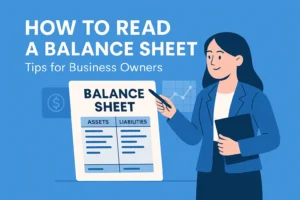A balance sheet is one of the most important financial statements for any business. Whether you’re a startup founder or an established entrepreneur in Vancouver, understanding how to interpret a balance sheet is critical for making informed financial decisions. This guide will walk you through the basics of reading a balance sheet and help you gain a clearer picture of your company’s financial health.
What Is a Balance Sheet?
A balance sheet provides a snapshot of your business’s financial position at a specific point in time. It details three primary components:
- Assets: What the business owns
- Liabilities: What the business owes
- Equity: The owner’s share in the business
The balance sheet is essential for analyzing your business’s solvency and liquidity. Learn more about financial statement compilation services we offer.
Key Sections of a Balance Sheet
1. Assets
Current Assets include cash, accounts receivable, and inventory. Long-term Assets might include property, equipment, or intangible assets.
2. Liabilities
These are your company’s obligations. Current liabilities are short-term debts, while long-term liabilities refer to loans and obligations due in more than a year.
3. Equity
This section reflects the residual interest in your company after liabilities are subtracted from assets. It includes owner’s capital and retained earnings.
Want expert assistance? Check out our joint venture and partnership accounting services.
Tips for Interpreting Your Balance Sheet
- Compare periods: Always review balance sheets over time to identify trends.
- Check ratios: Use key financial ratios like the current ratio or debt-to-equity ratio to assess financial health.
- Verify accuracy: Make sure assets equal liabilities plus equity. This keeps the balance sheet “balanced.”
For deeper insight, read our article on how to use financial data for business growth.
How a CPA Can Help
Hiring a CPA is a smart move for business owners who want to improve their financial literacy and compliance. At Judi Wang, CPA, we help you:
- Understand complex financial reports
- Stay compliant with CRA regulations
- Improve budgeting and forecasting
Explore our financial consulting services to take the next step.
Start Taking Control of Your Finances Today
Don’t wait until tax season to get your finances in order. Understanding your balance sheet is a powerful step toward better business decision-making.
Ready to get help from a professional? Schedule an appointment or contact us today to get started.
Focus key phrase: balance sheet basics
